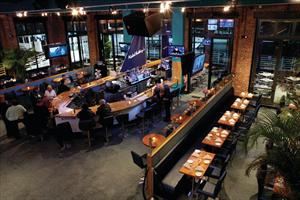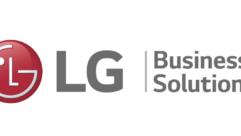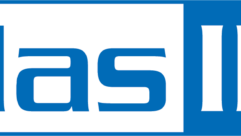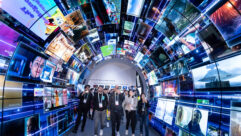

Doing Business in Hospitality AV
AV pros says the restaurant and hotel markets are gradually improving. But selling new AV systems to those customers isn’t business as usual. Certain trends are driving hospitality customers.
Michael Anthonys Waterfront Restaurant in Jersey City, N.J., employs Control4 technology to help route content to 20 displays, three projectors, two stages, and 10 audio zones. Local integrator Wanderlogic handled the design and installation.
As the U.S. recession deepened in 2008 and 2009, people and companies cut back. For households, that meant cutting back on family vacations and eating out. At offices throughout the country, it meant fewer business trips. The net result was fewer people traveling, staying in hotels, attending conferences, or eating at new restaurants.
“2009 was a tough year, but 2010 was a bounce-back year,” says Fred Gerhart, president of Impact Group, a firm that offers production support for corporate events, meetings, and trade shows. “Hotel sales are still off, but they’re improving.”
Does that mean AV professionals can begin applying the same strategies to the hospitality sector as they did before the recession? Not quite.
Hospitality By the Numbers
- In 2009, the lodging industry generated $16 billion in pretax profits, according to the American Hotel and Lodging Association. Revenue was $127.2 billion, down from $140.6 billion in 2008.
- The U.S. Department of Labor’s Bureau of Labor Statistics sees the hotel industry growing a total of 5 percent between 2008 and 2018.
- The restaurant industry enjoyed 2010 sales of $580 billion, according to the National Restaurant Association (NRA).
- More than seven out of 10 of the nation’s 945,000 restaurants and bars are single-unit operations, which is to say that they’re not part of chains, says the NRA.
This shift in focus means that an AV designer or integrator needs to know more than how to hang LCD TVs. “You need to know how to field-terminate Cat-5 cable, basic networking concepts, and explain to the client about fiber transport and high-definition media,” Tassey says.
“There are now more processors, amplifiers, and other rack-room components to support more sophisticated AV systems, but there isn’t more space,” Saenz explains. “Larger hotels may split the rack roomsone for the convention center and one for the hotel rooms. Another space-saving solution is to install racks in catwalks.”
Top 10 Largest U.S. Hotel Chains
- InterContinental Hotels Group
- Wyndham Worldwide
- Marriott International
- Hilton Hotels
- Accor
- Choice Hotels
- Best Western
- Starwood Hotels & Resorts
- Carlson
- Global Hyatt
Source: MKG Hospitality
“For example, what’s changed in the meeting business is that the definition of a large event is now half the size,” Gerhart says. “A smaller meeting means less need for presentation technology.”
Other corners of the hospitality market are also approaching recovery cautiously. “We’re seeing more specifications written, which indicates that the market is preparing for action once capital is available,” says Dan Saenz, marketing manager for Crown Audio. “There is a strong preference in the hotel sector for cost-effective solutions.”
“Clients still have a safe but curious mindset,” says Roy Scardina, executive director at Swank Audio Visuals. Sardina says that 2009 marked a change in the meeting industry. “Today, clients are looking for more value. Prerecession trends, like elaborate projection systems, are used much less.”
Still, AV companies agree, hospitality’s purse strings are loosening. If you match what you’re selling to what hotels and restaurants are looking for in a postrecession market, you’re likely to capitalize. Here are a few critical trends.
Trend 1: Network Robustness
Hospitality venues, specifically hotels and restaurants, must invest in new AV technology to attract customers. Why would anyone dine at a restaurant with CRT TVs when they can go to practically any other restaurant and regale in banks of high-definition flat-panel TVs? But as AV technology advances, and both audio and video signals go digital, the emphasis in hotels and restaurants is on the quality of the distribution network.
“Both hotels and restaurants are looking for the capability to send a central AV and data source to multiple destinations for cost efficiency,” says Jim Tassey, project engineer with Ford Audio-Video Systems. “A venue needs an industrial-strength infrastructure to handle it all. So the focus turns to redundancy and a plan to minimize failures.”
Trend 2: Owner Preference Dictates AV
Hotels and restaurants are service-driven businesses, so it’s a little surprising that, increasingly, restaurant and hotel operators drive AV designnot necessarily customers and their preferences.
Install Snapshot: Flexible AV
The new Overton Hotel and Conference Center in Lubbock, Texas, prides itself on being a modern venue that can meet the needs of todays meeting and conference professionals. In addition to its attached 15-story hotel, the Overtons showcase meeting space is the Sunset Ballroom, an 11,250-square-foot space that can divide into three separate rooms with their own AV systems.
The hotels AV systems for the ballroom, meeting rooms, boardrooms, restaurant, and lounge were designed by Acoustical Design Group of Mission, Kan., and installed by the Moyers Group of Lubbock. “What makes this design unique is that there is permanently installed audio in the ballroom, but all of the video systems are portable,” explains Phillip Brown, system design consultant with the Moyers Group. “This allowed for flexible video screen options based on need.”
Three portable video systems were designed around Panasonic PT-DW7700U-K multimedia projectors and Da-Lite 16-by-9-foot Heavy Duty Fast-Fold screens with a drapery kit and a movable cart. The ballroom uses Biamps AudiaFlex digital signal processing platform to provide the matrix audio for either the large room configuration or the individual rooms in wired or wireless configurations.
The AV inputs are automatically switched with the opening and closing of the walls. Each divided room has custom Whirlwind wall plates on all four walls for maximum room configuration options. The plates offer two microphone inputs, one line-level input, and one system output. A total of 30 Electro-Voice EVID C8.2HC ceiling speakers powered by two QSC CX series amplifiers provide audio coverage to the entire room. Four Shure UR1 wireless body packs with earset microphones and two Shure UR24D/Beta87A dual wireless microphones are shared amongst the rooms. Additional system control and routing options are accessed via an ELO TouchSystems 1529L touchscreen that is mounted with other AV components in a Middle Atlantic WRK-44SA-27 equipment rack.
–LSF
“Restaurant owners are very budget-conscious. Unless it’s a novelty restaurant, there isn’t a big investment in innovation or new technology,” explains Steve Langevin, president of Advanced Lighting & Sound. “Still, AV design varies based on the owner’s wants and needs. If I can get an owner to attend a demo, selling them on upgrades is easier after they’ve heard and seen the technology.”
Langevin likens his job to that of a residential installer. “Working in a small restaurant is similar to working in someone’s house,” he says. “The owner’s connection to the place is personal and buying decisions are emotional.” And like today’s homeowners, hospitality operators are careful with their money. “What the owner wants is what the audience gets,” Tassey says.
When it comes to hotel AV services and meeting support, it’s the meeting planners and producers who are driving AV system design. Companies such as Impact Group and Swank Audio Visuals must walk a fine line between providing the requested AV systems for a meeting and evaluating the situation to determine if more advanced AV technology, such as portable telepresence solutions, would be sufficiently attractive to enough clients.
Gerhart says that his company makes expensive technology investments only after conducting thorough research and then sells the idea to the client if it’s appropriate. “It’s a balancing act,” he says, “because the equipment is usually stored at a hotel site. So it’s not generating revenue elsewhere when it’s not in use.”
Doing Business in Hospitality AV
AV pros says the restaurant and hotel markets are gradually improving. But selling new AV systems to those customers isn’t business as usual. Certain trends are driving hospitality customers.
In restaurants, consumer brands such as Bose and DirecTV have penetrated the market more than pro brands. “People tend to go with the brands they know,” Tassey says. “You are fighting consumer brand awareness versus professional brand awareness. For the AV integrator, you need time and patience to educate the customer on why professional brands are better for the application.”
Trend 3: Consumer Brands Make More Headway
Overton Hotel and Conference Center
Some AV manufacturers have gone so far as to provide pro versus consumer talking points for their distributors and dealers. These talking points cover everything from duty cycles to heat tolerance and ventilation, and from a product’s ability to interface with control systems to warranty terms.
Langevin, who works with Bose Direct Solutions and DMX Direct, says he focuses on installation details and lets the manufacturer handle the sales and design work. “As a small company, I’ve been able to install AV in places like Capital Grille, whereas I would’ve only worked with small bar and restaurant owners on my own,” he says.
Under the Bose Direct Solutions business models, Langevin’s firm is hired as a subcontractor to complete the install with the respective manufacturers taking care of all other details, including client service, system design, and accounts payable. Langevin has even added support services for phone and security systems to his company’s repertoire so that he can offer one-stop tech support to clients.
Looking ahead to the coming year and beyond in hospitality AV, Scardina thinks the next three years will provide slow but steady growth for AV services. “We’ve seen an increase in client requests for satellite feeds to support webcasts, and some meeting planners are trying to figure out how to incorporate Twitter, Facebook, and other social media elements to engage and promote their event,” he says. “There is an opportunity for AV to solve the new challenges of the new economy, such as technology to support virtual trade shows that are used to supplement a live meeting.”
In the meantime, Tassey says the technology-adoption curve will still stay midway between early adopters and tried-and-true technology. “Hotels and restaurants are a very competitive market, so the AV technology needs to be trendy enough to draw people into the venue but reliable enough to run on a 24/7 duty cycle.”
Linda Seid Frembes is a freelance AV writer and frequent contributor to Pro AV.









